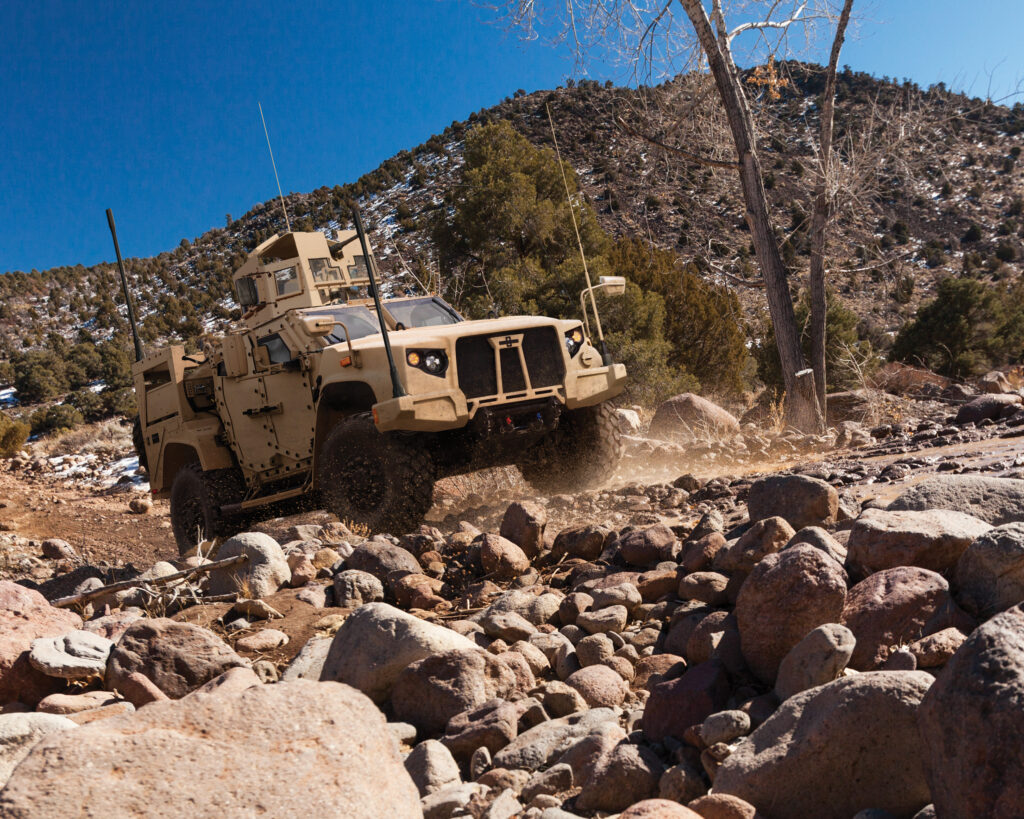
PENTAGON: You wouldn’t have known it from the way the Army announced it, but the service awarded arguably its most important contract in a decade this evening to build the first 17,000 Joint Light Tactical Vehicles (JLTV) to Oshkosh.
“The JLTV production contract is a historic win for Oshkosh Corporation and more than 300 suppliers in 31 states across the country, and most importantly, for America’s warfighters,” says Charles Szews, Oshkosh CEO. Oshkosh beat back impressive efforts by Lockheed Martin and AM General to win today’s $6.75 billion contract. We’ll find out in the next 10 days if either or both of them file a protest. Many observers expect just that and the program officials at this evening’s briefing were unwilling to say virtually anything about why Oshkosh won or the strengths or weaknesses of any of the three competitors. They clearly feared giving someone grounds for a protest. Scott Davis, head of the Army’s Program Executive Office Combat Support & Combat Service Support, told us “there is no expectation of a protest,” but his language was very carefully chosen. They may not expect a protest, but that doesn’t mean they aren’t worried one will be filed.
Sen. Tom Cotton, in whose state the Lockheed version would have been built, appeared to open the door to political pressure to change the results when he issued a statement this evening that included the pledge that “as Lockheed Martin explores their next steps, we stand ready to assist them however we can.” Since the fixed price low rate initial production contract with eight options has been awarded, about the only next step would be a protest.
How committed was Lockheed Martin to this competition? It bought partner BAE Systems’ entire wheeled vehicle production line and physically moved it from Sealy, Texas to Camden, Ark.
The JLTV will replace most of the US military’s Humvees, the iconic vehicle built by AM General. The Marines are getting 5,500 JLTVs and the rest go to the Army. Up to 40,000 JLTVs will be built through 2040.
The Humvee was conceived of when tactical vehicles could roll without too much risk of being blown up by some kind of landmine (the Pentagon calls them Improvised Explosive Devices but they are landmines or anti-tank mines). When I asked how the JLTV might change how the Army and Marines fight, I was told this evening that the new vehicle would basically restore mobility that had been taken for granted when the Humvee was designed. The assembled experts at this evening’s briefing said the JLTV would basically get US ground forces back to where they were supposed to be before Humvees started getting blown up.
“The JLTV program fills a critical gap in the U.S. military’s current line-up,” John Urias, the president of Oshkosh Defense. “The Oshkosh JLTV fills that need by providing the blast protection of a light tank, the mine resistance of an MRAP, and the off-road speed and mobility of a Baja racer.”
Each of the three companies built 22 prototype vehicles which were tested over 14 months.
Here’s the excellent summary of the JLTV program Sydney did earlier this summer:
What’s so awesome about JLTV? When you look at the three competitors’ vehicles, they all look pretty much like trucks. In fact, they look like smaller variations on the blocky theme of roadside-bomb-resistant wheeled vehicles — uparmored Humvees, Mine-Resistant Ambush Protected (MRAP) vehicles, M-ATVs — that became as iconic of the conflicts in Afghanistan and Iraq as the Jeep was of World War II.
Appearances, however, can deceive.
The first crucial difference is what the JLTV is meant to do: combine the protection of the bulky MRAPs with the off-road agility of the original unarmored Humvee, before layers of added armor weighed it down. Mobility matters both on the attack and on defense, because the best protection against a roadside bomb is to get off the road. Mining a key chokepoint along a predictable route is easy. Mining all possible cross-country approaches is not.

